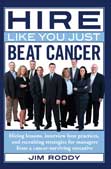Introduction
 Why title a book Hire Like You Just Beat Cancer? I’ll give you the short version of my story:
Why title a book Hire Like You Just Beat Cancer? I’ll give you the short version of my story:
- From 1993 to 1998, I was a self-employed sole proprietor, publishing a monthly magazine about high school, college, and minor league pro sports in northwestern Pennsylvania. It was called SportsLook. I’m certain you never heard of it.
- In 1998, harried by self-employment stresses such as 70-hour workweeks and the inability to afford anything other than SpaghettiOs for dinner, I took a real job as managing editor for Jameson Publishing. A publisher of national IT trade magazines and websites, Jameson is headquartered in my hometown of Erie, Pennsylvania.
- Since I had success with hiring on the editorial and production side of our business, the owners asked me to help interview and hire sales employees. After a couple sales candidates asked, “Why am I talking with an editor?” the owners changed my title to operations manager. It lacked the fanfare you see in the movies when someone is promoted, but it was a move up.
- Then I got cancer.
I was only 32 years old. I had to tell my teenage brother that if surgery showed that my colon cancer had spread to other organs, I might not be around through the end of his basketball season. As you can imagine, we were both scared and shared a long cry.
I also had to tell my boss and co-workers that even if things went well, I was going to be out of commission for two months after surgery. And, due to chemotherapy treatments, I would work only part time for most of the next year. If things didn’t go well, the team would move on without me.
Before my diagnosis, I’d thought I understood the importance of hiring top-notch people. But it took being forced to step away from my co-workers for an extended period of time (with one of the options being stepping away forever) for me to realize that the people you hire truly make or break your business. It doesn’t matter if you have the best product, best systems, best location, or a spotless reputation. Your situation will change eventually. When that happens, who’s going to make the right adjustments to your business? Your people.
I hope you achieve two primary outcomes by reading this book.
- I hope that, like me, you realize the people you hire will make or break your business. (But, unlike me, I don’t want you to have to get cancer to learn that lesson.)
- I hope you learn time-proven principles and techniques that will help you hire world-class co-workers.
At Jameson Publishing, where I’m now company president, we’ve made sure that every hiring manager understands those two lessons. Our company principles, which are posted on seemingly every wall in our headquarters and satellite offices, talk loudly about how to “Establish A World-Class Organization”:
- Employ only the best.
- Attract, hire, and retain quality employees who can build the company better than our current best.
- Pay higher-than-market salaries and bonuses on top of that.
- Incentivize to make employees feel the way the company feels.
- “Install managers who are among the ablest, most earnest, and reliable in the field of business.” – J.D. Rockefeller
- Build a reserve of capable employees who can move up to fill positions created by growth.
- Have at all times at least one subordinate with the ambition, people skills, technical competence, and values who could take over your position today.
- Cause managers to hire bench strength even for their star performers and for themselves.
- Offer jobs only to applicants you believe can grow beyond their starting position with us. To do otherwise runs the risk of not having enough capable employees to fuel our growth.
- Offer jobs to applicants capable of solving all the problems they’ll encounter. We’re flunking if it requires the department head to solve the department’s problems.
- Make room for capable employees who could grow into department heads or division presidents, so we don’t lose them.
- “Build a force of enthusiastic, loyal, harmonious co-workers.” – Harvey Firestone
In Hire Like You Just Beat Cancer, you’ll see short, easy-to-digest chapters filled with detailed examples and principles your business can adopt. You’ll read about time-tested best practices your organization can implement immediately. If you do, I’m certain your business will improve. I know it’s worked for us at Jameson. We’re not the biggest business-to-business publisher in North America, but I’d put the quality of our employees up against those of any other publisher.
For example, our employees did a phenomenal job during the Great Recession of 2008. They understood the need to do more with less. To stay in business, we were forced to lay off several employees. And the ones who stayed took a hit financially. Operations employees went for more than two years without pay raises. Managers lost their overtime pay. With our revenue off nearly 33%, the take-home pay of most sales employees dropped by $10,000– $40,000. On top of that, for the first time in company history, we stopped our dollar-for-dollar 401(k) match. For 1 year, 11 months, and 9 days. (Yes, I was counting.) You’d think employees wouldn’t have been able to work with all the complaining going on around them. But that’s not what happened.
Our employees didn’t complain, and they didn’t just hold down the fort. They innovated and positioned each of our products to take advantage of growing sectors in their industries. In 2010, we grew our sales 20%, enabling us to turn on manager overtime pay and our 401(k) match. We began hiring again, because we had more customers to take care of. It was a monumental accomplishment in a tumultuous time. Our customers love our employees, and so do I.
Before we get on with the meat of this book, I should let you know that I’ve been cancer-free since 2002. I try to not think much about cancer, and I won’t dwell on cancer throughout this book. But the lessons I learned when cancer knocked me down helped build me up as a hiring manager, and I apply those lessons aggressively every time we interview a potential employee.
Disclaimer: The information in this book and on this website is provided with the knowledge that the publisher and author do not offer any legal or other professional advice. In the case of a need for any such expertise, consult with the appropriate professional.
This book and website do not contain all information available on the subject of hiring. This book and website have not been created to be specific to any individual’s or organization’s situation or needs. Every effort has been made to make this book and website as accurate as possible. However, there may be typographical and/or content errors. Therefore, this book and website should serve only as a general guide and not as the ultimate source of subject information.
This book and website contain information that might be dated and is intended only to educate and entertain. The author and publisher shall have no liability or responsibility to any person or entity regarding any loss or damage incurred, or alleged to have been incurred, directly or indirectly, by the information contained in this book or website. You hereby agree to be bound by this disclaimer.

